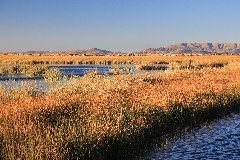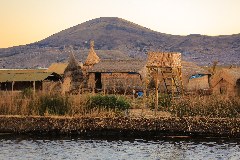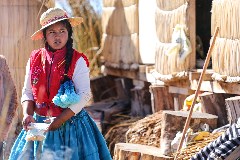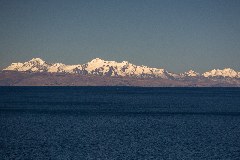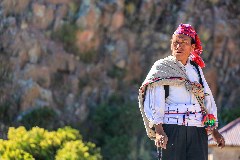Sea 4km above other seas
Sailing at almost 4000 masl, sleeping on floating island, islanders of Taquile - the weird weird Titicaca
Machu Picchu is not the only legendary place in Peru. There is also Titicaca. The epic Indian lake and the highest large lake in the world. I never knew too much about Titicaca, but just hearing its name always pumped up my heart beat.
Now that I do know something about Titicaca, let me share some basic info. It really is the highest large lake in the world, and highest navigable body of water on this planet. It lies on border of Peru and Bolivia, high up on Altiplano (Andean high plateau) at almost 4000m, with area of 8300 km2. That is one sixth of Slovakia! Can you imagine that much water somewhere 4km above you? And apart from all of this, according to Incan mythology it is the birthplace of the Sun.
The Altiplano is a tough place. It’s so high that there is practically no vegetation. It’s a dry, cold, harsh, sad place, where oxygen level is well below anything anyone on the planet is used to, with exception of the Tibetans. It takes few hours of travel through the Altiplano to arrive to Titicaca’s tourist capital Puno. Relatively easygoing town, but cold. In the mornings you could see ice on the streets. Interstingly, people look different in Puno than elsewhere in Peru. Their faces are more round, more flat, more… Bolivian. It is obvious that here around Titicaca the ethnicity of the people starts to change, and indeed, these people come from different Indian tribes that the Incas and other peoples of Peru. And also the local hat style is different :-)
Nowadays, the major attraction of Titicaca are “floating islands”. These islands are actually boats. There are huge chunks of reed tied together, and they float on the lake. People live on these floating islands, have their homes there and even keep their animals on them. As the reed soaks and dissolved, the islands need constant maintenance to keep them afloat. The local people have lived there for centuries. It is believed that they started to live on these reed islands to protect themselves from attacks of the Incas. These days people probably live there, because it is all they have. If you cannot afford to buy any piece of land, you can still make yourself a reed island and live on it. Luckily, the tourists come by boatloads, and most of their income today comes from the tourists. But some of the communities (the reed islands are always grouped together and they form some sort of floating villages) refuse all visitors and they live in their traditional way (which probably involves eating a lot of fish!).
Let’s be honest, it is a bit of Disneyland. You hop on a boat in Puno, in 15 minutes you arrive to one of the villages, pay the entrance, the locals show you their island, sell you some souvenirs, take you for a boat ride in their “traditional” reed boat, and in 30 minutes you are gone back to Puno. This is surely not world’s most authentic experience, but that could hardly be expected in place so famous and so poor at the same time. We decided that instead of just visiting the floating islands we would sleep there in one of the houses made of reed. Us and 4 more people from our boat did it, the rest 25 returned to Puno. In the tiny house, there were just 2 shitty beds and each of them with 4 blankets each weighting 10kg. The heaviest blankets in the world. They ought to be, as it gets freaking cold here. In the morning everything was frosty and we were praying for the sun rise to heat us up. While shivering in our clothes, hats and gloves, the local family was walking around barefoot. These people are hard!
If I ever complain about my life, please remind me about Titicaca. These people live on floating reed islands, in the middle of a lake, located at almost 4000m above the sea level! There is no firm land, no vegetation, no warmth and not even the stupid oxygen! This must be the world’s toughest place to live! You don’t have latest smart phone and fancy car? Imagine having no firm land and no oxygen…
After the freezing morning the boat came to pick us up, we quickly visited one more reed island and then continued to proper island Taquile. By proper island I mean a real island, made of rocks and land. One cannot be sure in this area :-)
Taquile looks like Mediterranean - pines and introduced eucalyptus trees and azure water near the shore that contracts with otherwise dark color of the lake. No road, no cars. Just quiet, veeery quiet life. The local people belong to distinct ethnicity and they still wear their folk dress, which makes the place even more eye pleasing. The boat ride there took maybe 2 hours. It is bit surrealistic to be floating in a boat, 4km above the sea level!!! From the boat, somewhere on horizon of this enormous lake which feels like sea you can see white, snow covered mountains somewhere in Bolivia. Amazing view.
From Taquile island we returned to Puno for the night, last portion of pollo asado (roasted chicken – typical Peruvian dish) and the next morning we returned back to Cuzco, our base camp in the region. And then the last long, annoying ride in Peru, back to Cuzco, then to Lima next morning and off to Panama via Bogota. This was one of the craziest and longest transfers of my life! Luckily no plane was cancelled and this so chain of transports didn’t fail and soon we were back to northern hemisphere in Panama City.
